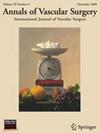Technique and Long-Term Results of Laparoscopic Aorto-Bi-Femoral Bypass for Juxta-Renal Aortic Occlusion
IF 1.4
4区 医学
Q3 PERIPHERAL VASCULAR DISEASE
引用次数: 0
Abstract
Background
Describe the technique and the long-term results of total laparoscopic aorto-bifemoral bypass for juxtarenal aortic occlusion (JRAO).
Methods
From December 2000 to January 2023, 16 patients with a JRAO (TASC D lesions) underwent total laparoscopic aorto-bifemoral bypass. The patients’ database was prospective and the file analysis was retrospective.
Results
Median age was 61 years (33–79). Ten patients had debilitating intermittent claudication, and 6 patients had severe critical ischemia. All patients were operated on through a laparoscopic left retrorenal approach. One conversion to open surgery was performed. Median operative time was 315 min (240–470). Median total aortic clamping time was 97.5 min (53–140). Median suprarenal aortic clamping time was 16 min (4–23). No hospital mortality nor severe systemic complications occurred. We observed variations in renal function during hospitalization and during the follow-up. However, no patients required early or long-term dialysis. Median follow-up was 116 months (1–213). Two patients developed bilateral femoral pseudoaneurysms (43rd and 186th months). No patient developed false aortic aneurysm. An aortobifemoral bypass was occluded on an antiphospholipid syndrome (151st month). Eight patients died during the follow-up.
Conclusions
This series shows that total laparoscopic aortic approach of JRAO is feasible and safe in good surgical risk patients. It represents an additional approach of JRAO at the era of complex endovascular procedures.
腹腔镜主动脉-双股旁路术治疗肾旁主动脉阻塞的技术及远期效果。
简介:描述全腹腔镜主动脉-双侧旁路术治疗肾旁主动脉闭塞(JRAO)的技术和长期效果。方法:自2000年12月至2024年1月,对16例JRAO (TASC D病变)患者行全腹腔镜主动脉-双侧旁路手术。患者数据库是前瞻性的,文件分析是回顾性的。结果:中位年龄61岁(33-79岁)。10例患者有衰弱性间歇性跛行,6例患者有严重的临界缺血。所有患者均经腹腔镜左肾后入路手术。一例转为开放手术。中位手术时间315 min(240 ~ 470)。主动脉夹紧时间中位数为97.5 min(53-140)。中位肾上主动脉夹持时间16 min(4-23)。无院内死亡和严重的全身并发症发生。我们观察了住院期间和随访期间肾功能的变化。然而,没有患者需要早期或长期透析。中位随访时间为116个月(1-213)。2例患者发生双侧股骨假性动脉瘤(第43个月和第186个月)。无患者出现假性主动脉瘤。因抗磷脂综合征(第152个月)阻塞主动脉-股动脉旁路。8例患者在随访期间死亡。结论:本研究表明,腹腔镜主动脉全入路JRAO在手术风险较好的患者中是可行且安全的。它代表了复杂血管内手术时代JRAO的另一种方法。
本文章由计算机程序翻译,如有差异,请以英文原文为准。
求助全文
约1分钟内获得全文
求助全文
来源期刊
CiteScore
3.00
自引率
13.30%
发文量
603
审稿时长
50 days
期刊介绍:
Annals of Vascular Surgery, published eight times a year, invites original manuscripts reporting clinical and experimental work in vascular surgery for peer review. Articles may be submitted for the following sections of the journal:
Clinical Research (reports of clinical series, new drug or medical device trials)
Basic Science Research (new investigations, experimental work)
Case Reports (reports on a limited series of patients)
General Reviews (scholarly review of the existing literature on a relevant topic)
Developments in Endovascular and Endoscopic Surgery
Selected Techniques (technical maneuvers)
Historical Notes (interesting vignettes from the early days of vascular surgery)
Editorials/Correspondence

 求助内容:
求助内容: 应助结果提醒方式:
应助结果提醒方式:


